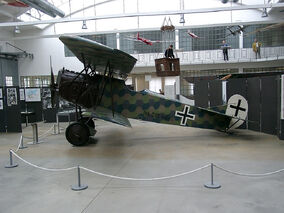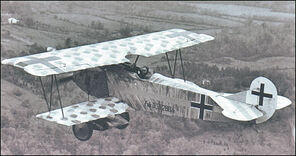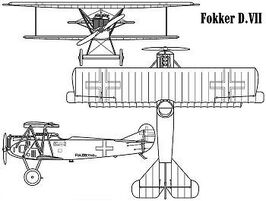A competition for a new German fighter design was held in February 1918. The Fokker D. VII won the competition and was subsequently considered to be one of the best fighters produced during World War I. Most of the German aces piloted them at one time or another. (Ernst Udet was one of them.) Robust and manoeuvrable, they exceeded the performance of all the Allied fighter planes, except in the area of top speed. Over 3000 were built by Germany, and another 200 by the Austro-Hungarian Empire .

Fokker D.VII in a museum
History[]
By late 1917 the Allied Air Forces on the Western Front were being equipped with French SPAD VII and British S.E.5 fighters. These aircraft shifted the air superiority balance towards the Allies. The German government decided they needed the same type of boost, so they issued an order for new German fighter type aircraft designs. The aircraft submitted were to be compared at a competition held at the Berlin-Adlershof airfield in early 1918. At least 31 designs/aircraft were submitted. Of these, the Fokker D. VII was selected to go into production under the supervision of Reinhold Platz, the chief designer for Fokker-Werke at the time.
Construction[]
The Fokker D. VII was a conventional design. A braced (Strutted?) biplane with a rigid frame, a water-cooled engine and two synchronized machine guns. Under the fabric covering of the fuselage was a sturdy, welded tubular steel frame as was used in earlier Fokker designs. The wings were made of wood, covered with cloth. The main load bearing wing struts separated the wings from the fuselage (I need help here. Can't tell from the photograph) but there were also inter-wing struts for their psychological value to the pilots. Lateral and horizontal stabilizers were also constructed from steel tubing and were fabric covered .
The initial order was for 400 aircraft, but Fokker's production alone could not produce this many in the required time. Consequently their rival, Albatros, produced a very similar aircraft with a wooden air-frame due to licensing issues.. (??)
A total of about 3,200 D. VIIs were made. Producers included Fokker in Schwerin with 1000 and Albatross(??) -Johannisthal with 2200. Additional aircraft (no known production figures) were built at the Albatros Werke ( OAW ) in Piła.
Use 1918[]

Fokker D.VII in WWI
The Fokker D. VII was an important aircraft to the Germans because of its excellent flight characteristics. These characteristics made it much easier to train new pilots, and to keep less experienced pilots out of trouble in the skies. Among other things, the D. VII apparently had a very low stall speed, no matter what it was doing.
The major engine types used were the Mercedes D III or BMW IIIa. From what I am editing, it seems that engine performance for the BMW engine may have been dependent on altitude. (Air density effects.) It appears that the D. VIIf model, at least, was equipped with this engine. The problem was that the engine only worked at maximum efficiency at altitudes above 3200 meters. (Around 10,000 feet.) Getting up to 3200 meters might take a while, but it is suggested that the D. VIIf could then 'hang by their propellors' at this altitude, and still have reserve power. This can be devastating to the enemy in aerial combat.
The D. VII also had the Big Three for WWI fighter pilots. First: light and stong, second: agile, and third: they allowed excellent visibility for the pilot. The first operational D. VIIs appeared on the Western Front in April 1918, assigned to Jagdgeschwader I, and immediately became very popular with German pilots. At first the Allied pilots had little respect for the D. VII because they were kind of boxy, and ugly. (This from people who had the S.E 5 on their side?) Not like the elegant Albatros fighters at all. This attitude was changed very quickly.
It appears that Manfred von Richthofen, Commander of JG I, either flew, or wanted to try, the D. VII before his death in a Fokker Dr. I (Dreidecker or tri-plane.)
OP says that many people thought that a D. VII could not make a mediocre pilot into an ace, but reminds us that the war ended in November 1918, while the first D. VII didn't get to an operational unit until April. For a seven month career, the D. VII seems to have made quite an impression. As 1918 dragged on, the Allies fielded new aircraft, not just in reponse to the D. VII, but in an attempt to stop the carnage. The new Allied aircraft had increased power and the German pilots were begging for more D. VIIf's, but that model doesn't appear to have ever gone into full scale production.The OP suggests that, in September 1918, there were about 800 D. VIIs active at the front line, assigned to 48 Jagdstaffeln. It is possible that 200 of these were the 'f' model.
Eight 'f' model aircraft were delivered to the Bulgarian Aircraft Division in September 1918 .
Post-war use[]
The D. VII is not mentioned in the Treaty of Versailles 1919, but is in the Terms of the Armistice. Most of the planes went to the U.S., some in the Switzerland. Many of the delivered aircraft were destroyed, others served the U.S. Air Force for many years as a training aircraft.
Immediately after Germany's defeat Fokker moved his business in the Netherlands. He smuggled parts for 120 machines D. VII and CI engines, and 300-400 over the border and built on the D.VII . The aircraft was used in several air forces, including the Netherlands, Lithuania, Poland, Czechoslovakia, Hungary, the Soviet Union, Denmark and the USA. The Belgian armed forces to use captured aircraft converted to two-seaters, as a training aircraft until 1926 . The Dutch Air Force They flew until 1931 and even 1928, Switzerland ordered eight new aircraft of this type.
Specifications[]
- Wingspan: 8.93 m ( upper wing ) and 7.01 ( lower wing )
- Length: 7 m
- Height: 2.75 m
- Weight: 757 kg ( empty) and 959 kg ( loaded)
- Engine: Mercedes D. IIIau, 6 cylinder (180 hp) or BMW IIIa (185 hp)
- Speed: 200 mph ( sea level)
- Maximum ceiling: 6,000 m
- Flight Duration: 1.5 hours
- Armament: Two Spandau machine guns of 7.92 mm 8.15 LM
The original article can be found at Fokker D.VII and the edit history here.
